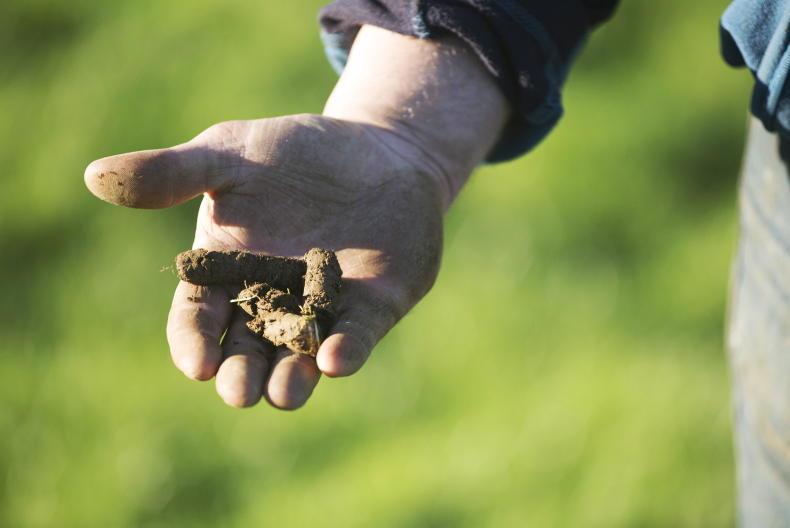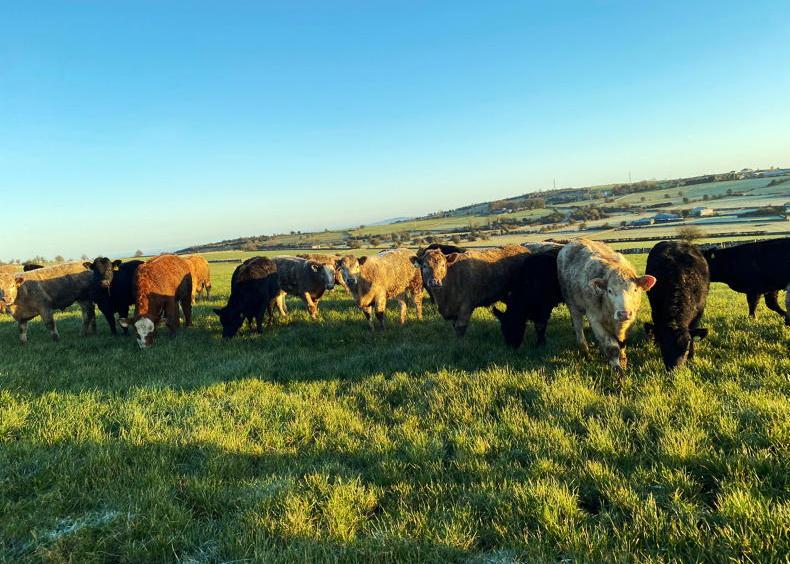Soil test results
Soil sampling on Tullamore Farm revealed that 30% of the soils are at optimum levels for phosphorus (P), potassium (K) and soil pH according to the 2024 soil test results.
That is a soil pH of 6.3 or above and P and K index levels of three or four. This is 12% above the Teagasc national average, but there is still plenty of improvements to be made.
While there has been a reduction in pH levels from the 2022 results, 70% of the soil remains at optimum pH levels. Soil pH levels are good overall, largely due to the soil types on the farm. The average soil pH is 6.71 and in 2022 this was 7.34.

Taking soil samples is crucial to determine where to reduce artificial fertilizer use.
While the pH remains at a good level it has seen decreases; this could be due to a number or reasons such as soil type, heavy rainfall leading to leaching and the application of sulfur which lowers soil pH. Nitrogen and phosphate fertilisers are acid formers, which have the potential to lower the overall pH of the soil.
Building soil P and K levels
Where silage has been produced, the soil K levels are often lower, and these levels must be raised. But it is difficult to raise soil K levels by spreading slurry if the K content of the soil is low. Building soil K levels with farmyard manure containing straw could be a possibility, but the process will take time. The slurry from finishing cattle can help low-pH soils because the animals are fed rations, which should increase the P content of the slurry.
Biodiversity
A biodiversity assessment on Tullamore Farm, conducted as part of the BRIDE project, will be detailed at the upcoming open day. The Farm Biodiversity Index (FBI) for this farm is 5C. The farm has 5% of its area classified as SFN, indicated by the ‘5’ – the average quality of the SFN is rated as ‘C’.
There were several recommendations from the BRIDE project some of which include: not topping hedgerows can increase habitat quality, FBI score and un-topped hedgerows improve carbon sequestration. Mature, uncut hedgerows flower and provide fruit, supporting insects, birds, and mammals.
Ivy in hedgerows benefits late-season pollinators. Important foraging habitat for bats and acts as ‘corridors’ for nocturnal movement. Riparian Buffer zones of an average widths of 3m+ provides habitat and shelter for wildlife along the riverbank and intercepts nutrients from surface runoff to protect water quality.
Sustainability trail
At the open day, the Footprint Farmers programme will be showcasing a comprehensive list of implemented sustainability measures. A sustainability trail will guide visitors around the farm, pointing out various efforts to enhance biodiversity and sustainability. Be sure to look out for the informative posters along the way.
Combi crop at the open day
During the walk this year, visitors will have the opportunity to see the combi crop that was sown on 20 April this year. 1.6ha of combi crop was sown at a seeding rate of 70kg per ha to qualify for the protein aid scheme. The decision was made to grow this crop to produce high-protein silage and reduce the cost of meal fed to the weanlings.
The crop will be harvested in late July and baled before it begins to ripen, ideally when the grain is at the cheesy stage. These bales, with an expected high protein content of approximately 18%, will be used to feed the weanlings, providing a nutritious and cost-effective alternative to purchased feed.
Additional information and cost details will be available on the day, allowing visiting farmers to examine the crop up close.
Incorporating clover
Reducing nitrogen on Tullamore Farm is a goal that we are achieving year-on-year. Planting multi species sward in 2022 has helped reduce N use and prolonged the grazing season.

Clover scoring results will be announced at the open day.
Despite challenging growing conditions this year, the multispecies sward remains abundant with varieties and continues to produce good covers. The multispecies sward has been grazed every three weeks by cattle and sheep at a heavy cover of 1700 kg of DM.
Soil test results
Soil sampling on Tullamore Farm revealed that 30% of the soils are at optimum levels for phosphorus (P), potassium (K) and soil pH according to the 2024 soil test results.
That is a soil pH of 6.3 or above and P and K index levels of three or four. This is 12% above the Teagasc national average, but there is still plenty of improvements to be made.
While there has been a reduction in pH levels from the 2022 results, 70% of the soil remains at optimum pH levels. Soil pH levels are good overall, largely due to the soil types on the farm. The average soil pH is 6.71 and in 2022 this was 7.34.

Taking soil samples is crucial to determine where to reduce artificial fertilizer use.
While the pH remains at a good level it has seen decreases; this could be due to a number or reasons such as soil type, heavy rainfall leading to leaching and the application of sulfur which lowers soil pH. Nitrogen and phosphate fertilisers are acid formers, which have the potential to lower the overall pH of the soil.
Building soil P and K levels
Where silage has been produced, the soil K levels are often lower, and these levels must be raised. But it is difficult to raise soil K levels by spreading slurry if the K content of the soil is low. Building soil K levels with farmyard manure containing straw could be a possibility, but the process will take time. The slurry from finishing cattle can help low-pH soils because the animals are fed rations, which should increase the P content of the slurry.
Biodiversity
A biodiversity assessment on Tullamore Farm, conducted as part of the BRIDE project, will be detailed at the upcoming open day. The Farm Biodiversity Index (FBI) for this farm is 5C. The farm has 5% of its area classified as SFN, indicated by the ‘5’ – the average quality of the SFN is rated as ‘C’.
There were several recommendations from the BRIDE project some of which include: not topping hedgerows can increase habitat quality, FBI score and un-topped hedgerows improve carbon sequestration. Mature, uncut hedgerows flower and provide fruit, supporting insects, birds, and mammals.
Ivy in hedgerows benefits late-season pollinators. Important foraging habitat for bats and acts as ‘corridors’ for nocturnal movement. Riparian Buffer zones of an average widths of 3m+ provides habitat and shelter for wildlife along the riverbank and intercepts nutrients from surface runoff to protect water quality.
Sustainability trail
At the open day, the Footprint Farmers programme will be showcasing a comprehensive list of implemented sustainability measures. A sustainability trail will guide visitors around the farm, pointing out various efforts to enhance biodiversity and sustainability. Be sure to look out for the informative posters along the way.
Combi crop at the open day
During the walk this year, visitors will have the opportunity to see the combi crop that was sown on 20 April this year. 1.6ha of combi crop was sown at a seeding rate of 70kg per ha to qualify for the protein aid scheme. The decision was made to grow this crop to produce high-protein silage and reduce the cost of meal fed to the weanlings.
The crop will be harvested in late July and baled before it begins to ripen, ideally when the grain is at the cheesy stage. These bales, with an expected high protein content of approximately 18%, will be used to feed the weanlings, providing a nutritious and cost-effective alternative to purchased feed.
Additional information and cost details will be available on the day, allowing visiting farmers to examine the crop up close.
Incorporating clover
Reducing nitrogen on Tullamore Farm is a goal that we are achieving year-on-year. Planting multi species sward in 2022 has helped reduce N use and prolonged the grazing season.

Clover scoring results will be announced at the open day.
Despite challenging growing conditions this year, the multispecies sward remains abundant with varieties and continues to produce good covers. The multispecies sward has been grazed every three weeks by cattle and sheep at a heavy cover of 1700 kg of DM.











SHARING OPTIONS